Affiliate links on Android Authority may earn us a commission. Learn more.
A closer look at the Axon phone’s “Hi-Fi Audio”
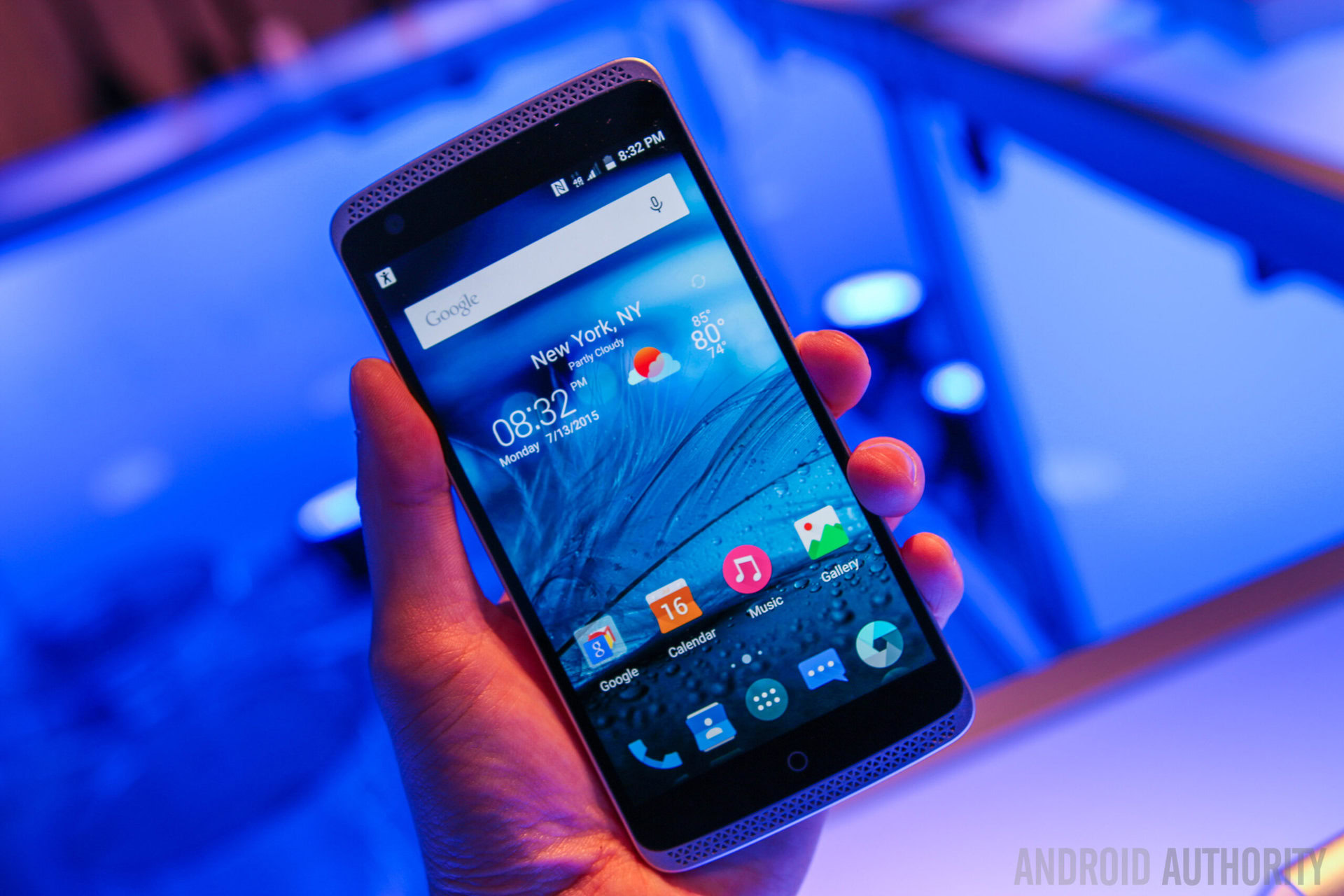
Last week, ZTE launched its new Axon smartphone in the US, which boats some top of the line specifications at a price that substantially undercuts the competition. One of the big selling points is the Axon phone’s “Hi-Fi Audio”, but with lots of smartphones offering hi-resolution playback it’s worth looking at what separates the Axon from the rest.
The Axon phone boasts a “Premium 32-bit” AK4490 DAC which supports sample rates up to 192 kHz, features five digital filters, and AKM’s “Velvet Sound” technology. This is coupled with an AK 4961 codec used for recording functionality, which offers four differential channel 24-bit ADCs that operate up to 96 kHz.
So let’s take a look at this audio jargon in a little more detail.
32-bit playback, really?
Firstly, the Axon’s “Hi-Fi Audio” is capable of 32-bit 192 kHz audio file playback, which trumps the introduction of 24-bit 192 kHz capable flagship smartphones that have hit the market over the past year or so, at least on paper. I say on paper because bits and audio are a lot like megapixels and cameras, bigger numbers don’t always produce higher quality results.
You probably won’t be able to find a lot of 32-bit source material to playback, most high-quality audio downloads come at most as 24-bit 192 kHz files. Even then, you could fill up the Axon’s 32GB of memory pretty quickly with lossless files of that size, so it’s not an immediately useful addition. More importantly, the on paper capabilities of the codec don’t necessarily match up with real-world implementations.
“Customers told us what was missing from today’s smartphones, and low-quality audio was one of the biggest sticking points.” – ZTE
When we talk about audio bit-depth, from a consumer perspective, we mean the number of points available with which to record or playback the waveform’s amplitude. 16-bit CD quality audio offers 65,535 points (-32,768 through 32,767), 24-bit studio quality files offer 16,777,216 possible values (−8,388,608 to 8,388,607) and 32-bit files reach a huge 4,294,967,296 range.
People often confuse bit-depth with the resolution “accuracy” of something like a camera image or incorrectly think about smoothing out signal “stair-stepping”. But the real purpose of higher bit-depth at the recording and playback stage is to improve the signal to noise ratio (SNR). 32-bit math processing is a different matter. This is done by increasing the number of points between the peak signal and the noise floor (dynamic range) and reducing distortion caused by rounding errors, something which dithering also addresses.
On paper, an ideal 16-bit signal has an SNR of 96dB, 24-bit has 144dB, while 32-bit theoretically jumps to 192dB.
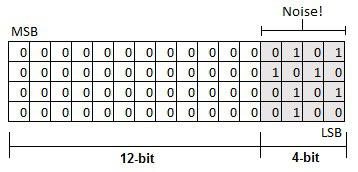
However, there are physical limitations to the actual SNR that can be achieved, which depends on hardware layout and the noise limits of integrated circuits. Real world high-end audio implementations are often limited to an SNR less than 132dB, which works out to 22-bits.
Jargon Buster:
(Signal to Noise Ratio) SNR – The difference between a nominal signal level and the average level of the noise floor. Dynamic Range is a similar measurement that looks at the maximum signal level and the noise floor. Larger values are better.
(Total Harmonic Distortion) THD – Additional signal content added as a single wave passes through a component. This is usually an odd or even harmonic of the original signal. This test is usually done with a 1 kHz sine wave and lower values are better.
(Intermodulation Distortion) IMD – Additional signal content added by a component when passing multiple signals of different frequencies. Content is not necessarily an integer harmonic, which can produce particularly ugly distortion.
So although an ADC or DAC may be theoretically capable of recording or playing back 24-bits of data or greater, you should actually look at the real world noise values to get a better idea of how close the hardware can actually get to the ideal.
With that understood, we can determine that the Axon phone’s 32-bit audio playback is actually a rather pointless marketing ploy. The chip itself promises a 120dB SNR, while the phone’s hardware layout seems to reduce this to 108dB, according to the launch presentation. So we’re actually only looking at noise floor equivalent to what we would get with an ideal 18-bit source.
The chart below shows a comparison of the dynamic range headphone outputs from a range of smartphones, and roughly what that equates to in terms of actual available bit-depth for playback.
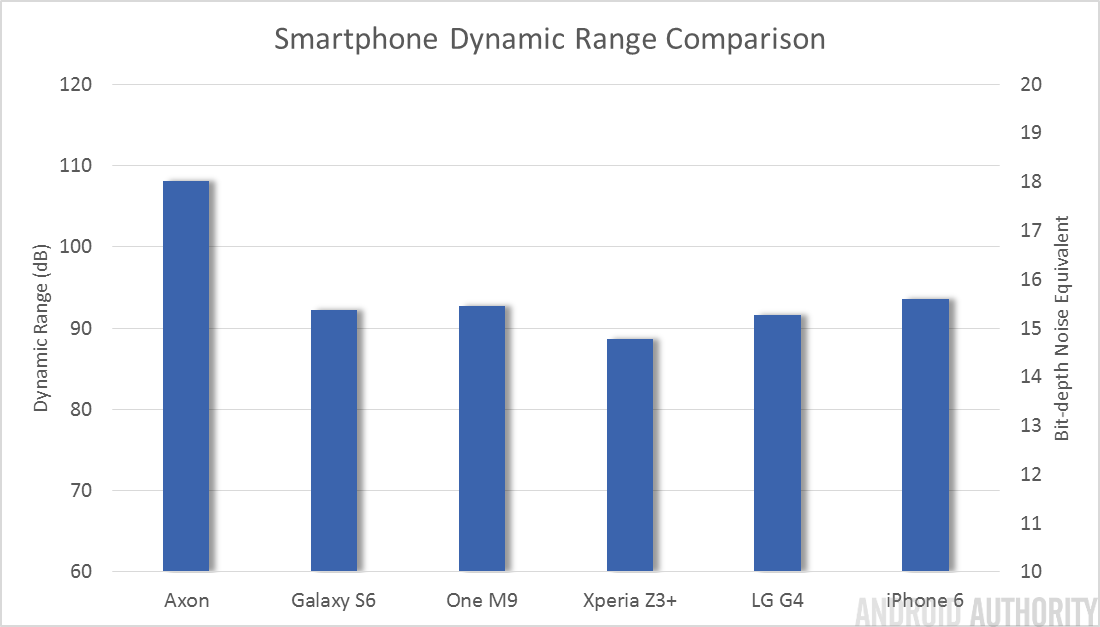
The Axon’s result is still very good for a smartphone and shows a noticeable improvement over competing handsets on the market. However, it doesn’t provide as big of a gap between the competition as the 32-bit tag line would suggest, and won’t lend itself to the full dynamic range offered by a 24-bit source, let alone a 32-bit file.
All of that said, by the time we take the average listening environment, volume, and increased amounts of compression used in modern music, listeners will struggle to notice any difference between 16, 24 and 32-bit audio anyway.
Distortion Characteristics
The AK4490 DAC also offers up some improved Total Harmonic Distortion and Noise (THD+N) characteristics compared with other smartphones on the market. All audio hardware introduces some additional distortion and noise, including codecs, op-amps and speakers, most of all. A high-quality audio hardware chain should introduce less than 0.1% of additional content, or -60dB.
The Axon phone manages a THD factor of -97.7dB, which works out to 0.0013%. Typically, as output power increases THD rises as the speaker or driving chip works harder to increase the volume. The Axon phone retains its very stable -97.7dB all the way up to 10mW when driving quite typical 32 ohm headphones.
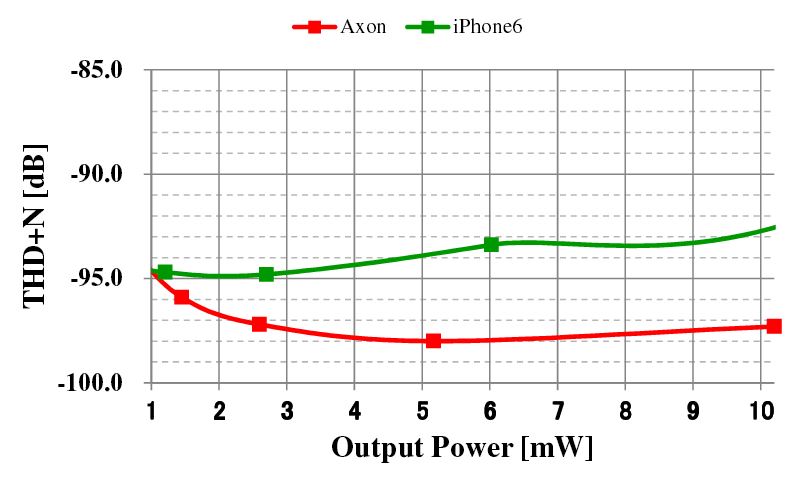
Compared with some of the leading flagship smartphones, the Galaxy S6’s THD measures around 0.0024%, the iPhone offers 0.0018%, the Xperia Z3 Plus measures 0.0049% and the One M9 comes in at 0.0082%. The Axon phone seems to offer the least distortion available in a smartphone and bests many of the current Android flagships by a notable margin.
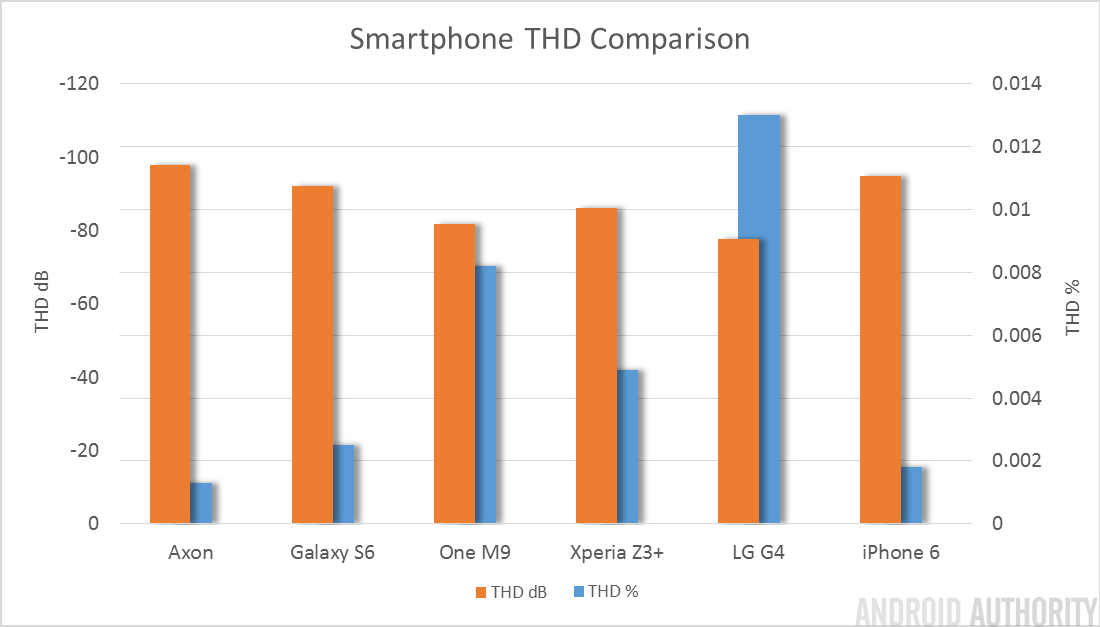
Perhaps a better distortion test for actual audio use is intermodulation distortion, which measures the additional harmonic content introduced by the system when two or more frequencies are sent through the system. Again, the Axon phone offers substantially less distortion than leading Android flagships, and also again bests Apple’s iPhone 6.
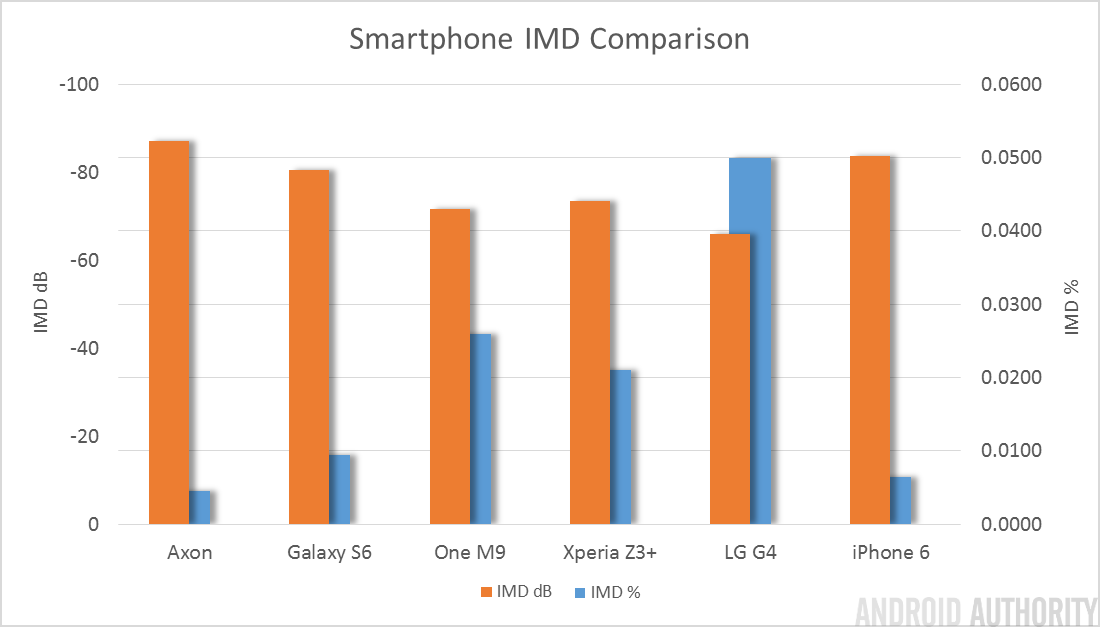
Apart from the pointless addition of 32-bit audio playback, the Axon phone indeed offers some significant important improvements in audio playback quality when compared with other flagship smartphones, and looks to be the best Android phone for audio playback on the market right now. The iPhone 6 and the Galaxy S6 are the two smartphones that offer the closest playback quality.
Recording options
Turning to the handset’s recording options, the Axon boasts a 24-bit ADC with dual-microphone for omni-directional recordings, using a microphone at the top and bottom of the device.
The two microphones can help more accurately pinpoint a sound within 20 meters from the phone. As for how it works, just imagine a sound traveling to your ears. The slight difference in space between the two means that a sound arrives at ever so slightly different times, which allows your brain to pinpoint the rough location. A single (or mono) microphone setup does not capture this time difference, but a stereo microphone setup can help preserve this additional sense of space.
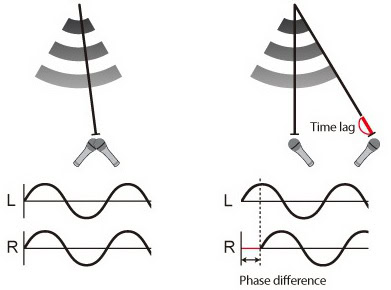
While this effect will probably work reasonably well when listening back through headphones, the decision to use a single speaker in the Axon phone means that this effect may not preserve quite the same sense of space when mixed down to a mono signal.
The ADC boasts 24-bit 96 kHz sound capture, but a quick check of the spec sheet SNR again suggests that the real-world usable bit-depth is actually closer to 17-bit, or 16-bit when the mic amp adds an additional 18dB of gain.
This is still more than good enough for high-quality, low noise audio capture, providing that the microphone is good enough, and the ability to capture stereo audio data through the use of two microphones should offer up a compelling sense of space. This could be a particularly nice feature to use in conjunction with the phone’s video capture.
Extra Features
ZTE has also picked an audio codec that comes with a built-in DSP core. The AK4961 can handle echo cancellation and microphone noise suppression for audio recording on the chip. It can also perform voice processing to enable voice commands and wake-up functions, as well as hands free functionality. Having these processes managed on the codec will save on the need for additional hardware or using up main CPU processing time.
Like all good codecs, the AK4961 and 4490 feature oversampling modes to reduce noise from out-of-band sources and make use of differential inputs and outputs to help prevent noise leaking into the signal path from additional sources.
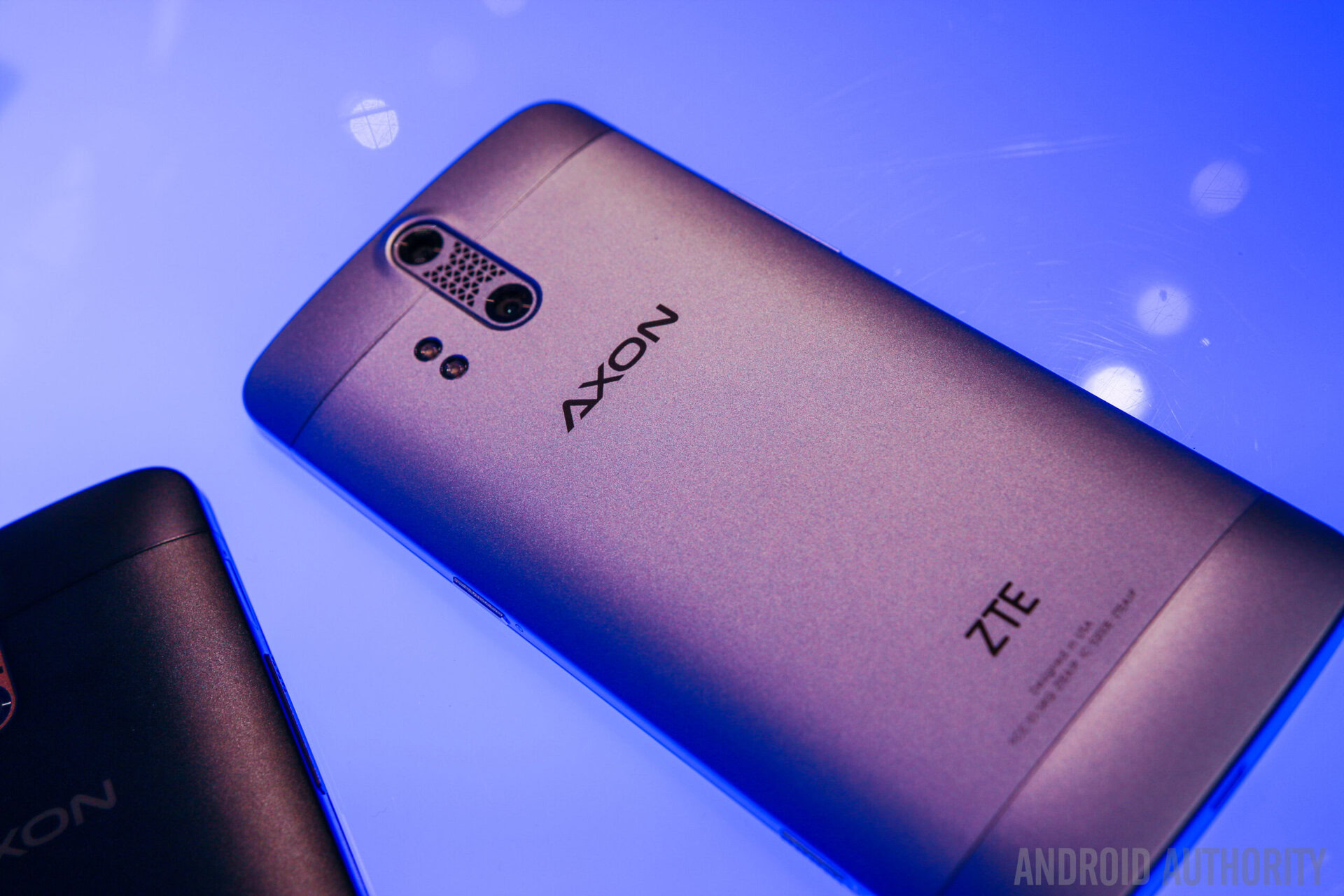
Wrap Up
Hopefully this breakdown has helped to give you an idea of the type of audio improvements that the Axon phone actually delivers and those that it can’t.
While a 32-bit “Hi-Fi Audio” DAC tag-line might be an easy sell, the reality is that the confined and noisy environments of a smartphone chassis are not going to allow hardware to operate anywhere close to that level of accuracy, if consumers could even notice the difference. However, the Axon phone’s choice of high quality ADC and DAC hardware does boast improvements to noise and distortion, which are sure to please audiophiles out there.
We’ll have some more time to spend listening to the phone when review time rolls around, so we won’t draw any final conclusions. But the Axon looks to be a step in the right direction for mobile audio lovers.
[related_videos title=”Axon Phone Hands on! ” align=”center” type=”custom” videos=”625499,625608,625832″]